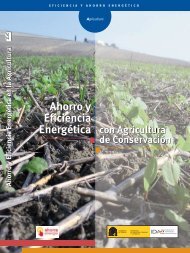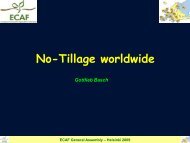E C O M I T - European Conservation Agriculture Federation-ECAF
E C O M I T - European Conservation Agriculture Federation-ECAF
E C O M I T - European Conservation Agriculture Federation-ECAF
You also want an ePaper? Increase the reach of your titles
YUMPU automatically turns print PDFs into web optimized ePapers that Google loves.
The 5th International Scientific Conference on Sustainable Farming SystemsE C O M I Tlevels in the monitored soil layer was very similar to the one obtained in the crop andresidue management trial (figure 2). Straw removal and the maintenance of stubbleslightly increased the SOM content in the 20 cm top layer, whereas straw return andadditional amounts of straw, which could occur under improved soil fertility conditionsor irrigation, increased SOM up to 0.2% in the topsoil layer within a period of 3 years.Both trials reveal the potential of the combination of no-till as non soil disruptive formof crop establishment and the return or maintenance of slowly degradable cropresidues such as wheat straw for the increase of SOM on the highly organic carbondepleted Mediterranean soils. These findings are in accordance with resultspublished by other authors (Dick et al., 1998; Clapp et al., 2000; Layese et al., 2002;West and Post, 2002) that report an increase of carbon incorporated into SOM whenchanging from intensive tillage to no-till, but only if harvestable carbon residues likestraw or cornstalks were left in the field. However, contradictory results can be foundin the review performed by Wilhelm et al. (2004), indicating that residue return maylead or not to an accumulation of SOM. Sanchéz et al. (2002), measuring the CO 2flux from conventional and reduced tilled fields, found a reduction of 6660 kg CO 2ha -1 year -1 under reduced tillage. This amount of carbon dioxide corresponds toaround 3000 kg SOM ha -1 , which is approximately the yearly SOM increase found inthe most favourable treatments in the trials, assuming a bulk density of 1.5.0.4change in organic matter (%)0.30.20.10-0.1Stubble Straw 2 x StrawStraw residue levels0-5 cm5-10 cm10-20 cm0-20 cmFigure 2: Relative changes in soil organic matter with depth under three levels ofwheat straw residues after 3 years.The evaluation of the total amount of SOC sequestered after only three years ofdifferentiated treatments is certainly questionable. Nonetheless, the differencesbetween crop type and residue levels and their management are considerable andgive evidence of the potential contribution of the combined effect of no till and cropresidue return to the build-up of SOM even under conditions of relatively low biomassproduction of Mediterranean rainfed agriculture. They also confirm that high C/Nratios of the residues are essential for the incorporation of crop carbon into SOM.65




